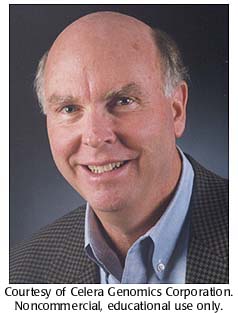Concept 39 A genome is an entire set of genes.

 Craig Venter and Francis Collins represent the commercial and the federally-funded efforts of the Human Genome Project.
Craig Venter and Francis Collins represent the commercial and the federally-funded efforts of the Human Genome Project.
- Go to:
- Francis Collins (1950-)
John Craig Venter (1946-)

J. Craig Venter began the race to sequence the human genome when he unexpectedly announced to a room full of genome researchers that they could just quit now, thank you, because his company would finish the job. People who like him say he never filters his thoughts and he shoots from the hip. Others have been less diplomatic, calling him an egomaniac, an idiot, and a shallow man.
John Craig Venter was born on October 14, 1946 in Salt Lake City, the youngest son of an excommunicated Mormon who drank too much, smoked too much, and died at 59. The family moved to a working class suburb south of San Francisco and lived in a house next to the train tracks. Venter enjoyed playing chicken with the trains and surfing the chilly waves in nearby Half Moon Bay.
In high school, Venter excelled in shop class. After graduating, he moved to Newport Beach to surf warmer waves, and then enlisted in the Navy during the Vietnam War. Detecting more intelligence in him than his high school record indicated, the Navy trained him as a medical corpsman and shipped him to the Da Nang hospital.
"I was there during the Tet offensive," he said. "I got introduced to medicine in probably the toughest way possible. I just got fascinated with the lack of knowledge we had and had a desire to do something more."
After finishing his tour — which included two stints in the brig for disobeying orders — Venter went to the University of California, San Diego to become a doctor. He was deflected from that path by a class with Gordon Sato and a project with Nate Kaplan. "I got so fascinated with science," he said, "I decided to heck with medical school."
Venter breezed through his undergraduate and graduate schooling in six years, worked at the State University of New York, Buffalo, and was recruited to the National Institutes of Health in 1984.
In the early 1990s, Venter developed the EST method of finding genes, and promoted it as cheaper and faster than the Human Genome Project that was just getting started. Project administrators disagreed, but in the meantime, the NIH decided to patent Venter's gene fragments. The Patent Office eventually rejected the patents, but the applications sparked an international controversy over patenting genes whose functions were still unknown. The Human Genome Project's director, James Watson, opposed patenting and quit. Venter left NIH to form his own non-profit institute, The Institute for Genomic Research (TIGR).
Venter continued EST work at TIGR, but also began thinking about sequencing entire genomes. Again, he came up with a quicker and faster method: whole genome shotgun sequencing. He applied for an NIH grant to use the method on Hemophilus influenzae, but started the project before the funding decision was returned. When the genome was nearly complete, NIH rejected his proposal saying the method would not work.
As he turned his focus to the human genome, Venter left TIGR and started the for-profit company Celera, a division of Applied Biosystems, the company that makes the latest and greatest sequencing machines. Using these machines, and the world's largest civilian supercomputer, Venter finished assembling the human genome in just three years. In 2006, several of Venter’s organizations merged to form The J. Craig Venter Institute (JCVI).
Venter was awarded the National Medal of Science in 2008 and lives with his wife — Heather — in San Diego, California.


A Time/CNN poll taken in June 2000 found 41% of Americans agreed with the statement that "developing technology to map the genome is morally wrong."

Do you think most people know what mapping is? Why would so many believe it's morally wrong?
 DNA is packaged in a chromosome.
DNA is packaged in a chromosome. Higher cells incorporate an ancient chromosome.
Higher cells incorporate an ancient chromosome. Some DNA does not encode protein.
Some DNA does not encode protein. Some DNA can jump.
Some DNA can jump. Genes can be turned on and off.
Genes can be turned on and off. Genes can be moved between species.
Genes can be moved between species. DNA responds to signals from outside the cell.
DNA responds to signals from outside the cell. Different genes are active in different kinds of cells.
Different genes are active in different kinds of cells. Master genes control basic body plans.
Master genes control basic body plans. Development balances cell growth and death.
Development balances cell growth and death. A genome is an entire set of genes.
A genome is an entire set of genes. Living things share common genes.
Living things share common genes. DNA is only the beginning for understanding the human genome.
DNA is only the beginning for understanding the human genome.